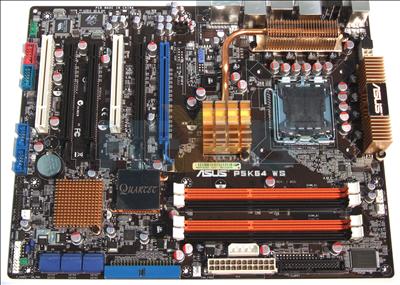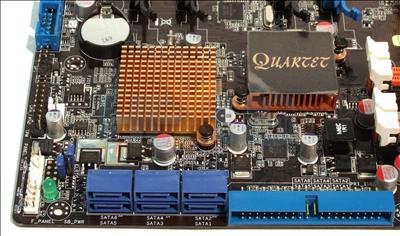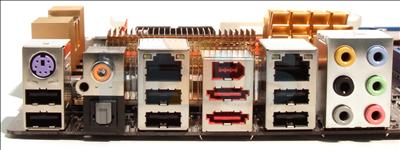Layout and features
Contrary to our initial expectations, the P5K64 WS's layout appears to share little in common with other P35-based ASUS boards.
The presence of the PCIe switch and the potential for four long graphics cards to be installed necessitates a change in how the core logic and various ports and connectors are positioned on the board compared with other members of the P5K range.
As with all ASUS high-end boards, the P5K64 WS has a black PCB and is fitted with a heatpipe cooling solution.
This is far less intricate than the one found on the P5K3 Deluxe, simply connecting the MCH's heatsink to that of one of the VRMs.
Although the CPU socket is enclosed on three sides by heatsinks, these all sit outside the LGA775 heatsink-exclusion area, so shouldn't interfere with most heatsinks.
The SSI power connector sits on the corner between the two VRM heatsinks, although a standard ATX12V connector can be used if the power supply is missing an eight-pin connector.
With the P5K64 WS, ASUS has chosen to support DDR3 memory - modules up to DDR3-1333 when used with a 1333FSB Core 2 Duo or Core 2 Extreme CPU. While the P5K64 WS's target market of professional workstations may be able to afford the extra cost of DDR3, our testing has so far shown practically no performance benefit over DDR2. So, we'd have preferred to have seen support for DDR2.
On a more positive note, the EATX power connector is well positioned along the board's edge, helping keep airflow through the case unimpeded and cabling simple. Alongside is a Molex connector for additional PCIe power. That helps to keep things tidy and is a big improvement compared to the long cable runs we've seen going to the middle of some motherboards.
Moving down the board, we find another pair of heatsinks. The PCIe switch is under the smaller heatsink marked 'Quartet', while the ICH9R is beneath the larger one.
Unlike the P5K Deluxe and P5K3 Deluxe, the SATA ports face off the side of the board. That avoids problems where long graphics cards, such as the GeForce 8800 Ultra, block off these ports and making them unusable. The IDE port also faces off the board. Further, the ports don't appear to be wholly compatible with some latching-style SATA cables. We tried to use our regular Akasa cables and found that considerable effort was needed to lock them into place.
All the usual front-panel headers are in this area, as is a header for a Trusted Platform Module but not the module itself.
The two pairs of two PEG slots are separated by a convention PCI slot. This avoids the situation found with the P5W64 WS Pro where three graphics cards installed in a row could lead to the heatsink of the second card causing a short against the back of the third.
We were able to get CrossFire working with any of the three black PEG slots, as long as the primary card was fitted to the blue slot. We also successfully tested the board with four Radeon cards, although we did not have enough monitors to test all the outputs simultaneously.
The one advantage of having a plethora of mechanical x16 PCIe slots lies with the ability to use x4 cards - RAID, for example - with the board.
Headers for ASUS's WiFi adaptor and ASAP Readyboost device, as seen on the M2N32-SLI Vista Premium, are silk-screened onto the PCB but not used.
Apart from lacking an aerial connector for onboard WiFi, the back panel is identical to those of P5K Deluxe and P5K3 Deluxe.
In contrast with those boards, however, the integrated Realtek ALC888 audio CODEC does not support Dolby DTS Connect or Dolby Digital Live.
Summary
The P5K64 WS resolves our main gripe with previous ASUS P35 boards we've looked at - the poor location and orientation of the SATA ports.
Other changes appear to be mainly to accommodate the PCIe switch, bringing support for four PEG slots.















